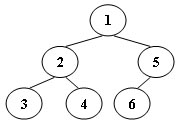03-树3 Tree Traversals Again
03-树3 Tree Traversals Again(25 分)
An inorder binary tree traversal can be implemented in a non-recursive way with a stack. For example, suppose that when a 6-node binary tree (with the keys numbered from 1 to 6) is traversed, the stack operations are: push(1); push(2); push(3); pop(); pop(); push(4); pop(); pop(); push(5); push(6); pop(); pop(). Then a unique binary tree (shown in Figure 1) can be generated from this sequence of operations. Your task is to give the postorder traversal sequence of this tree.

Figure 1
Input Specification:
Each input file contains one test case. For each case, the first line contains a positive integer N (≤30) which is the total number of nodes in a tree (and hence the nodes are numbered from 1 to N). Then 2N lines follow, each describes a stack operation in the format: "Push X" where X is the index of the node being pushed onto the stack; or "Pop" meaning to pop one node from the stack.
Output Specification:
For each test case, print the postorder traversal sequence of the corresponding tree in one line. A solution is guaranteed to exist. All the numbers must be separated by exactly one space, and there must be no extra space at the end of the line.
Sample Input:
6
Push 1
Push 2
Push 3
Pop
Pop
Push 4
Pop
Pop
Push 5
Push 6
Pop
Pop
Sample Output:
3 4 2 6 5 1#include<iostream>
#include<string>
#include<stack>
using namespace std;
int first=1;
typedef struct Dnode
{
int data;
struct Dnode *up;
struct Dnode *l;
struct Dnode *r;
}Tree;
void postOrderPrint(Tree *p)
{
if(p){
postOrderPrint(p->l);
postOrderPrint(p->r);
if(first){
cout<<p->data;
first=0;
}
else cout<<' '<<p->data;
}
}
int main()
{
int n,num,lastOpea=0,cnt=0;
string s;
Tree *p=new Tree;
p->up=p->l=p->r=NULL;
cin>>n>>s>>p->data;
stack<int>points;
points.push(p->data);
while(cnt<n-1 && cin>>s){
if(s.compare("Push")==0){
cin>>num;
Tree *tem=new Tree;
tem->data=num;
tem->up=p;
while(1){
if(p->data==points.top()){
if(!lastOpea && !p->l){
p=p->l=tem;
break;
}
else if(lastOpea && !p->r){
p=p->r=tem;
points.pop();
break;
}
}
else p=p->up;
}
points.push(num);
p->l=p->r=NULL;
cnt++;
lastOpea=0;
}
else{
if(lastOpea) points.pop();
lastOpea=1;
}
}
while(p->up) p=p->up;
postOrderPrint(p);
delete p;
return 0;
}

